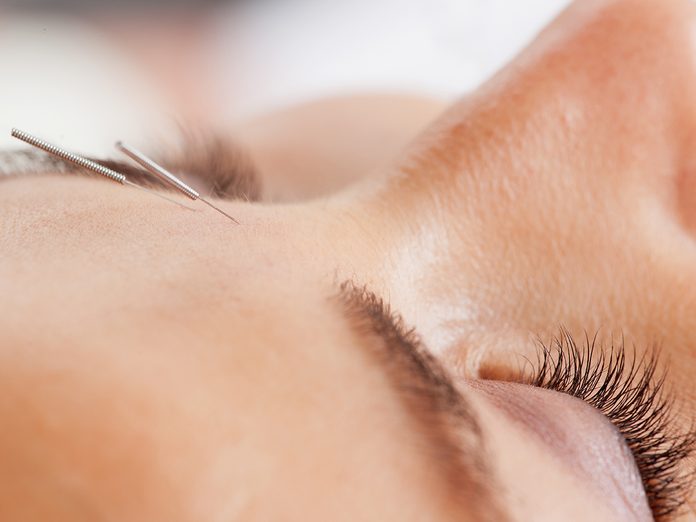Is Cosmetic Acupuncture Actually “Natural Botox”?

We tried an acupuncture facial to see if it could really give Botox-like results.
Quarantine boredom has led me to try a lot of different things. Challenging things like a Ritz Paris cake recipe, scary things like an acupressure mat, and things I was late to try, like gua sha. With many hits—excluding the Ritz Paris cake, which ended up looking like a pile of mac and cheese— I continued my hunt (read: scroll through Instagram) for feel-good activities to try, and I came across my next dare. French influencer Mathilde Lacombe posted a filter-free selfie highlighting her ridiculously smooth-looking forehead, and wrote no, she did not have Botox to thank for her ironed-out guise, but cosmetic acupuncture.
This wasn’t the first time I had heard about acupuncture for beauty benefits, but it was the first time I saw crazy-good results from it. Sarah Kreitzer, the owner of Acupuncture Center Toronto, had mentioned cosmetic acupuncture (also known as an acupuncture facial) to me when I interviewed her about facial cupping, and so I booked an appointment to try it for myself.
As you may know, acupuncture is an ancient Chinese medicine practice where a skilled practitioner inserts metal needles into the skin at pressure points believed to affect different parts of the body. Activating these pressure points is thought to help balance the body’s flow of energy known as chi or qi, and also stimulate nerves, muscles and connective tissue to relieve pain and ease tension.
With cosmetic acupuncture, the needles are placed primarily in the face to relax muscles and thereby smooth out lines and wrinkles, as well as sculpt and de-puff. “Common areas would be the frown lines and the vertical lines between eyebrows,” says Kreitzer, “and we use sculpting points that are found below the cheekbones.” These needles are tucked under the bone, she says, which can help give cheekbones a more lifted look.
Needles are also placed in other areas of the body that are thought to indirectly address cosmetic concerns on your face. “These points in the body have a reflex zone function,” says Kreitzer, giving the example of water retention in the face: “With that, we would probably stimulate points that strengthen the spleen and help disperse swelling or edema.”
Prior to my appointment, I filled out a lengthy form with questions ranging from my cosmetic concerns (breakouts, fine lines, etc.) to what I thought about my body’s circulation (I always have cold hands and feet). I’m asked if I’ve had Botox or filler, because acupuncture needles can botch the job. “If you’ve had work done with injectables, we can still do the treatment, but we wouldn’t be able to work directly on that part of the face,” says Kreitzer. I’m free of injectables, so pretty much every square inch of me is fair game.
At the appointment, I lie on the table, and Kreitzer places needles from my head to my toes. She inserts tiny thumb-tack-size needles around my mouth and forehead and longer needles under my cheekbones. She’s teaching cosmetic acupuncture to a couple of registered acupuncturists, so she has them place a few needles around my knees, ankles, and wrists. It’s a three-man job, to tackle all my health and beauty woes.
I’m left alone to lie in the room for 15 minutes and I contemplate taking a selfie—but I quickly abandon that idea as I imagine dropping my phone onto my needle-emblazoned face. After Kreitzer and her trainees take out the needles, she massages my face and performs facial cupping. “Massaging the skin after acupuncture really helps prevent bruising,” she says. The face bruises more easily than any other area of the body, so she also encourages her patients to massage their skin at home for a few days post-treatment.
Most people notice results after just one acupuncture treatment, says Kreitzer, but, I thought, I’m not most people. My skin throws temper tantrums at the introduction of any new product or technique, so I expect to see red dots or even a bit of swelling from the needles. But when I look in the mirror, I see super glowing skin, and a slightly lifted overall look—like I just woke up from a 12-hour sleep, and it’s the early 90s, and I’m a toddler. My skin is plump, in a well-hydrated, wrinkle-less way, and truly luminous.
The following day, my skin still looks good, but not quite as good as the day before. Maybe like I just woke up after a good night’s sleep in the early noughties. I’m inclined to go back for more treatments to see if, like Kreitzer says, I will see longer-lasting results. But I’ll space them out a bit since they’re $120 a pop. In the meantime, I’ll continue with at-home gua sha—while keeping an eye out for my next quarantine challenge.
Next: What to Know Before Booking a Laser Treatment for Your Face




